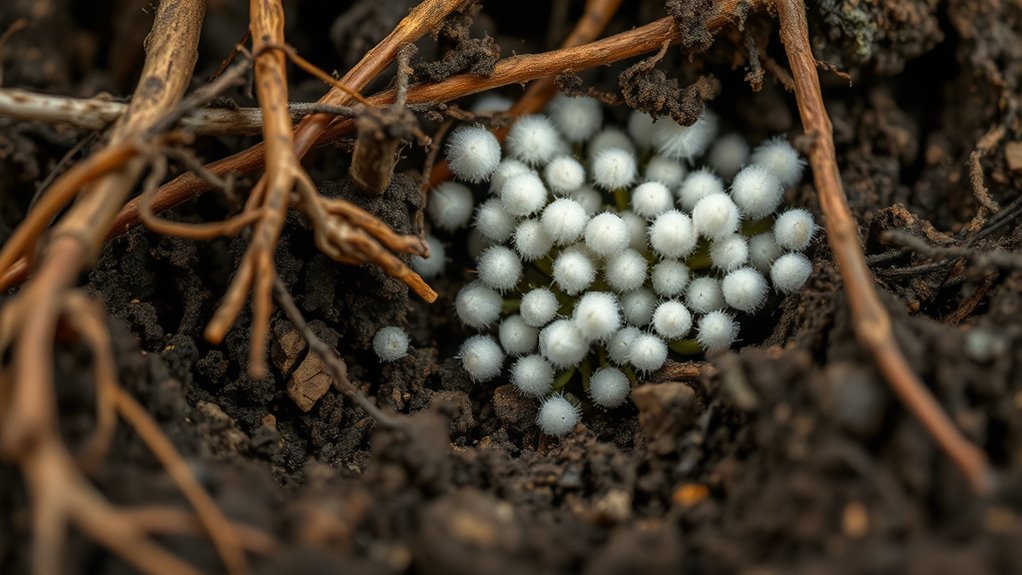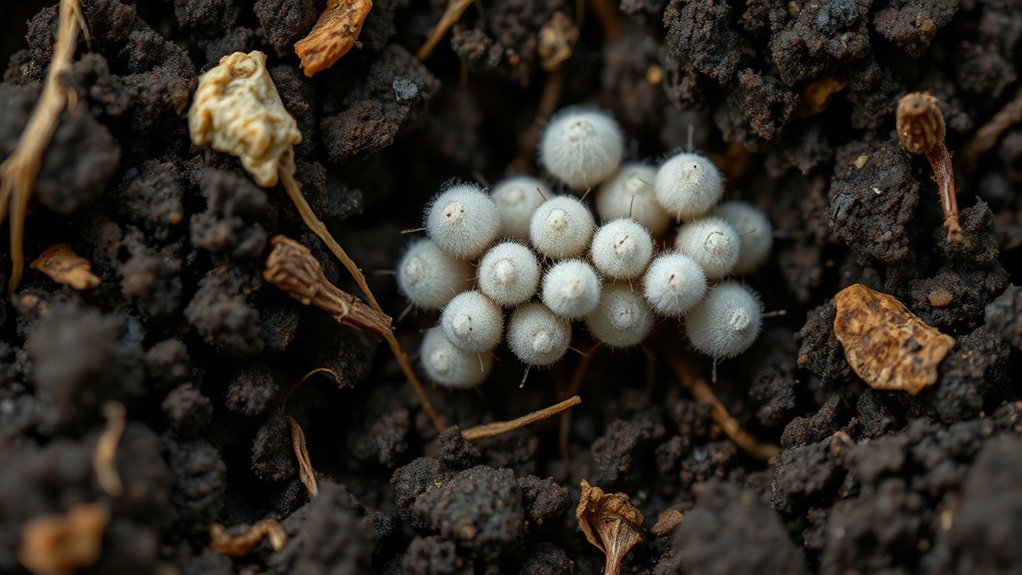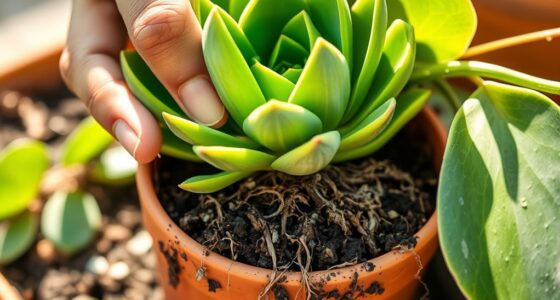Root mealybugs are hidden pests that attack your plant’s roots, making them hard to spot early on. They cause damage beneath the soil surface, leading to wilting, yellowing, and stunted growth before you see any aboveground signs. To manage these pests, use biological controls like beneficial nematodes or parasitic wasps, and adopt good cultural practices. If you want to learn effective strategies for detecting and controlling these sneaky pests, keep exploring ways to protect your plants.
Key Takeaways
- Root mealybugs infest plant roots underground, causing damage before visible aboveground symptoms appear.
- They hide in soil, making early detection difficult and increasing the risk of widespread plant health issues.
- Biological controls like parasitic wasps and beneficial nematodes effectively manage root mealybug populations naturally.
- Proper soil inspection, quarantine of new plants, and maintaining healthy soil help prevent infestations.
- Combining biological methods with targeted chemical treatments enhances overall eradication of root mealybugs.

Root mealybugs are tiny pests that attack the roots of plants, often causing severe damage before you even notice any aboveground symptoms. These pests hide in the soil, making them difficult to detect until your plant’s health visibly declines. When roots become infested, they struggle to absorb water and nutrients, leading to wilting, stunted growth, yellowing leaves, and sometimes plant death. Because they’re so well concealed, you need to be proactive in identifying and managing root mealybugs early on.
Root mealybugs cause hidden damage beneath the soil surface, threatening plant health before symptoms appear.
One effective approach to controlling these pests is biological control. This method involves introducing natural enemies like predatory insects or beneficial nematodes into the soil. For example, certain parasitic wasps target mealybugs specifically, reducing their populations without harming your plant or the environment. Beneficial nematodes, microscopic worms, can also be applied to the soil to seek out and infect mealybug larvae, disrupting their lifecycle. Biological control is a sustainable, eco-friendly option that minimizes chemical use and helps maintain the soil’s health while managing pests. Additionally, understanding the vibrational state of your soil environment can enhance the effectiveness of natural predators and nematodes, creating a more balanced ecosystem for pest control.
However, in cases of severe infestation, pesticide application might be necessary to protect your plants. When choosing pesticides, opt for products labeled specifically for soil-dwelling pests like root mealybugs. Apply these chemicals carefully, following the manufacturer’s instructions, and make sure to cover the root zone thoroughly. Be cautious with chemical use; over-application can harm beneficial soil organisms and lead to chemical resistance. Combining pesticide application with biological control strategies can often yield the best results, especially when you want to reduce chemical reliance while eradicating stubborn pests.
Preventing root mealybug infestations requires diligent soil inspection and good cultural practices. Quarantining new plants before introducing them into your garden helps prevent pests from spreading. Maintaining healthy, well-drained soil reduces stress on your plants, making them less vulnerable to pests. Regularly inspecting roots and soil for signs of pests can catch issues early, allowing you to intervene before damage becomes extensive.
Frequently Asked Questions
How Do Root Mealybugs Spread Between Plants?
Root mealybugs spread between plants mainly through soil contamination and plant-to-plant transfer. When you move infected soil or tools from one plant to another without proper sanitation, you risk transferring these pests. They can also crawl through the soil, reaching nearby plants. To prevent spread, always quarantine new plants, sanitize gardening tools, and avoid disturbing infested soil. Regular inspections help catch infestations early and limit their spread.
Can Root Mealybugs Survive Without a Host?
Root mealybugs can’t survive without a host plant; they’re like hitchhikers who depend on their host for survival. Without a plant to feed on, they struggle to live, relying on soil survival strategies to endure short periods. They stay hidden in soil, but ultimately, their existence hinges on constantly finding a new host. So, without a host plant, they can’t thrive or persist long-term.
Are Root Mealybugs Resistant to Common Pesticides?
You’ll find that root mealybugs often show chemical resistance, making them less responsive to many common pesticides. Their ability to withstand certain treatments can markedly reduce pesticide effectiveness, requiring you to use targeted or integrated pest management strategies. To combat resistance, consider combining chemical controls with cultural practices and biological options. Regular inspections and early intervention are key to managing these pests effectively and preventing them from causing extensive damage to your plants.
What Are Natural Predators of Root Mealybugs?
You can control root mealybugs naturally by introducing beneficial insects like ladybugs, lacewing larvae, and predatory beetles, which target these pests effectively. These beneficial insects are part of biological control methods, helping you reduce infestations without chemicals. By encouraging or releasing these predators into your soil or plant environment, you create a sustainable, eco-friendly approach to managing root mealybugs, keeping your plants healthy and pest-free.
How Long Is the Lifecycle of a Root Mealybug?
You’ll find that the lifecycle duration of a root mealybug typically spans 4 to 8 weeks, depending on environmental factors. During this time, it passes through several development stages: egg, nymph, and adult. The eggs hatch quickly, and the nymphs feed on roots, gradually maturing into adults. Understanding these stages helps you target infestations early and effectively manage these pests before they cause significant plant damage.
Conclusion
While root mealybugs may quietly hide beneath the surface, their presence softly whispers through your plants’ struggles. By staying vigilant and nurturing healthy soil, you create a welcoming environment that gently discourages these subtle invaders. With attentive care, you can restore harmony beneath the roots, allowing your plants to thrive in peace. Remember, a little prevention goes a long way in keeping your garden’s delicate balance beautifully intact.









